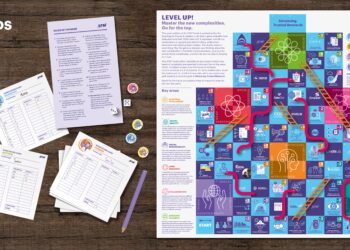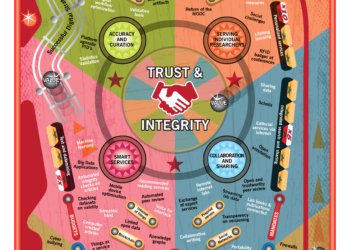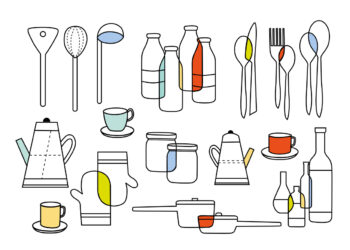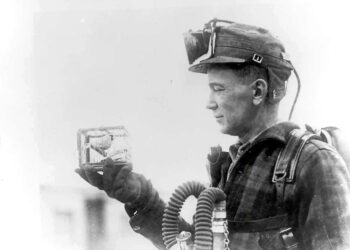As tumultuous as 2025 has begun, the STM Trends Report looking forward to 2029 provides a vision and a bridge to the future. Looking beyond the significant shifts and upheaval of today, the new report, which was released yesterday at the STM US Annual Conference in Washington, DC, shows us a path forward. Entitled New Coalitions: Fortifying the Foundations of Trust in Research, the analysis builds upon prior analyses to present a visual and narrative exploration of the risks, responses, and roles shaping the future of scholarly communications. Rather than highlighting specific technologies or trends, the New Coalitions report vision of our community in 2029, anchors its insight in the metaphor of a bridge. This conceptual structure links the many stakeholders and various efforts to counteract fragmentation and misinformation in the scientific ecosystem.
Developed as an output of a meeting hosted by STM each December in London during its Innovation and Integrity week of events, the Trends report is an annual forecasting project that identifies key trends and the drivers of change in scholarly publishing. The STM Trends 2029 builds upon a story arc that has been highlighted previous year’s reports. Whereas the 2028 Trends and previous years (or even other previous years) focused more on the emergence of technological enablers, such as artificial intelligence and open science tools, the 2029 approach pivots toward integration. As someone who regularly makes the point that technology is only an enabler, but requires social integration to drive adoption, the focus on integration is particularly powerful. This thematic reframing reflects a shift in concern from technological novelty to the stability of well-built infrastructure for knowledge sharing.
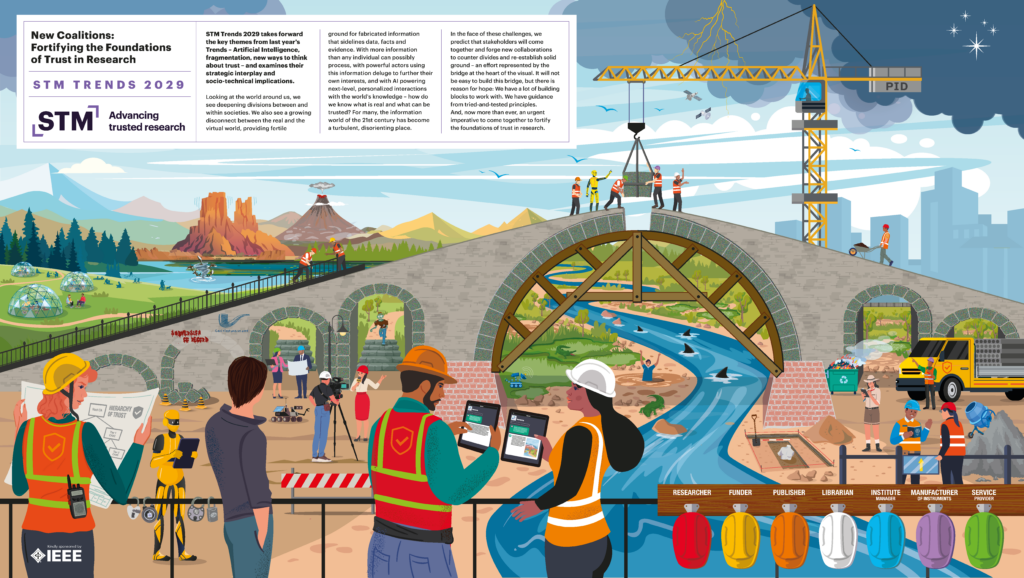
The Landscape in the Background
A range of issues impacting the ecosystem are displayed in the image that centers the report. Despite the seemingly bucolic background image, a range of pressures in our community are evident — from rising geopolitical tensions, societal distrust in science and expertise, to political and ideological dynamics affecting the academy. These are depicted visually in the Trends graphic as literal geological and environmental threats: earthquakes, a looming volcano, the pool of quicksand, predators, and a polluted lake. Each metaphorical threat, be it a lake swirling with fictionalized science, campers living in filter-bubble camps, zombies of fake science, or predatory organizations, makes traversing this landscape a threat.
One must consider, thoughtfully, the many visual cues in the image to catch their deeper meaning and the many layers of interpretation embedded in the image. With more than a few minutes of study, one begins to grasp some of the embedded messages. The image dramatizes the many existential threats facing the scientific publishing community in a way that makes abstract trends viscerally comprehensible.
Constructing the Bridge: A Metaphor for Multi-Stakeholder Collaboration
The visual metaphor of a bridge lies literally at the horizontal center of the 2029 report. Across the landscape littered with threats and challenges, the bridge represents a collective effort to cross the challenging landscape. The bridge here isn’t just a pathway to achieve safety by moving from one threatening side to the other. Rather, it is a mechanism by which the community can support each other on both sides, and a structure that provides solid ground in a world filled with marshes and quicksand. It counters the isolation and builds relationships among the partners working together to address challenges on both sides. A bridge can be the mechanism by which a new community can be forged and relationships reconstituted. Infrastructure can be the foundation for shared purpose and mutual reinforcement so needed in our current environment.
Critically, the bridge — as is all infrastructure — is not built by a single person, actor or institution. It is a collaborative architecture, constructed by a cast of stakeholders ranging from publishers and funders to researchers, librarians, platform providers, and even the public — represented poignantly by a watchful taxpayer. The architects, here represented by a triumvirate of publishers, libraries/research institutions, and funders are engaged in candid, open dialogues about their responsibilities, in this case to maintain research integrity.
A Bridge Going Up, But Still a Work In Progress
Despite all the tumult of today and the challenges that will likely still be present four years hence, the report is refreshingly optimistic in one crucial respect. The building of this bridge is neither a plan, nor a completed feature of our landscape. It is a work already in progress and much of the scaffolding already exists. The foundation of this bridge already exists in the form of standards, protocols, and exciting collaborative efforts to address these challenges. These include well-established initiatives such as COPE, CHORUS, GetFTR, and the STM Integrity Hub, as well as standards, technical infrastructures providers like Crossref and DataCite and the persistent identifier (PID) systems they support, which are represented as cranes in the visual — a nod to the heavy lifting they perform in connecting and validating research objects. Again, the progress of developing this infrastructure will take significant time, energy, and resources, much as building a solid bridge takes.
Other more nascent work in our present ecosystem includes trust markers, content provenance tracking and authenticity verification, and identity management systems inspired by the types of know-your-customer protocols in finance. These mechanisms are not just technical enhancements; they are instruments of knowledge verification — ensuring that researchers, institutions, and outputs can be confidently identified, authenticated, and held accountable.
Rather than proposing entirely new systems, the report foregrounds the reuse and expansion of existing infrastructures. These components are framed as “machinery” and “building blocks” of the bridge — concrete, proven elements that can be scaled or repurposed to meet today’s challenges. Similarly, the report visually acknowledges that even with these tools in place, the realization of this vision requires experimentation and supports. Pilots and provisional structures — represented as wooden scaffolds, where you’ll note the “AI” hidden in the scaffolding — are necessary to test these integrations before permanent fixtures can be fit into place. Extending the role of AI in the image, while enabling, is portrayed as double-edged. In the scene AI agents (robots) assist in bridge-building process, but some are seemingly roving about aimlessly, which is meant to remind us of the risks of misalignment or misuse of these tools.
Another particularly thought-provoking section of the image represents the tensions introduced by hyper-personalized search and retrieval agent systems. In this new developing paradigm of access and tooling, the two researchers visualized are shown querying the same concept. On their screens, they may receive different results, either shaped by invisible algorithms, the quality of their AI-Agent tools, geographic contexts, or institutional subscriptions.
An Imperfect Representation
No single representation or report can effectively capture the complexity of our rapidly evolving ecosystem. STM and this year’s editorial team (consisting of Nisha Doshi, Hylke Koers, Henning Schoenenberger, Heather Staines, Joris van Rossum and Anita de Waard) have done an admirable job. While building the bridge and its infrastructure implications are clear, it isn’t clear what the direction of travel is. The entire landscape is full of challenges on each side of the bridge, as is the river that it crosses. Perhaps, it is an acknowledgement that there is no “Dangerous place” we’re moving from or a “Safe place” we’re moving to. Even as the bridge isn’t completed, it isn’t clear who (or what) will be crossing the bridge? Is it the researcher community, some representation of the content, publishers, librarians or the public at large?
Also importantly, while the many stakeholders are represented in the image, the content of research — be it articles, data, software of other research impacts — isn’t deeply referenced. Of course, these are human processes, and the impacts of technology are inherently social. The processes of sharing research outputs aren’t simply about the processes or people. The role of content in our ecosystem shouldn’t be relegated to a sideline position in our analysis.
Also, while the report was developed out of discussions that took place before the current administration in the US took power, the implications of the administration’s actions were under-anticipated. Whether some of this future forecasting will survive contact with the radical shifts in policy is an open question. Although the taxpayer and journalists appear in the visual, their roles are passive. The mechanisms by which the public can engage with, influence, or benefit from trust in science are not clearly articulated. Given the somewhat populist approach of this administration, the impact of public perceptions on the academy could also play an important role in our market through the influence of public resources.
A Final Thought of Hope in the Future
The final motif in the Trends 2029 visual that I’d like to draw focus onto the padlocks affixed to the bridge in the foreground, like those on the Pont des Arts in Paris and now increasingly in bridges around the world. While they aren’t represented on the new bridge being built, they are meaningful and not just decorative. They represent the enduring commitments of the scholarly community to uphold the values enshrined in the North Stars shown on the top right. In an era of uncertainty, they symbolize permanence, intention, and shared responsibility. Through its use symbolism, the message in Trends 2029 is all too real. There are many threats and challenges in our ecosystem, but we collectively are committed to working together to solve these issues; to bridge to a brighter future.
Discussion
2 Thoughts on "New STM 2029 Trends Report Provides a Bridge to the Future"
I really really like this image, there’s more one can see in it, every time you look – a great explanation at the STM meeting, and write up by Todd – I particularly like the Sharknado and dumpster fire! Thanks all who created this!
It could be a stretch, but the leftmost rock tower that is vibrating (possibly singing–you need to zoom in to see it) reminds me of Devils Tower National Monument featured in the film Close Encounters of the Third Kind, suggesting that perhaps AI is not the only new form of intelligence we may encounter in the coming years. Let’s hope whether the intelligence originates on Earth or elsewhere, it is beneficent.
